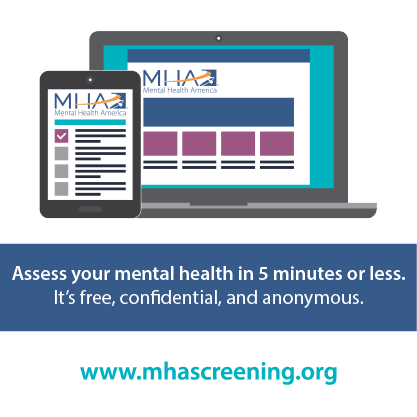Your MHA Staff Contacts
 Theresa Nguyen
Theresa Nguyen
Chief Program Officer and Vice President of Research and Innovation
tnguyen@mhanational.org or 703-838-7536
 Maddy Reinert
Maddy Reinert
Senior Director of Population Health
mreinert@mhanational.org or 703-797-1957
 Kevin Rushton
Kevin Rushton
Program Manager of Digital Solutions
krushton@mhanational.org or 703-838-7533
MHA Screening
Increasingly, individuals are turning to the internet to find mental health information and support. Over 5 million individuals visit Mental Health America’s Screening site every year. Many who visit MHA are seeking answers related to mental health disorders. Some of the top 10 Google Keywords that led people to MHA’s website were: “psychosis, depression test, PTSD test, am I depressed, bipolar test, paranoia, and mood disorders.”
MHA Screening is Mental Health America’s online screening tool (www.mhascreening.org). MHA Screening supports these individuals by providing an anonymous and confidential place to explore their symptoms, to learn more about mental health, and to get access to treatment.
We currently host nine screens – for depression, anxiety, bipolar, youth, parents, alcohol or substance use, psychosis, eating disorders, and PTSD. We also have depression and anxiety screens in Spanish currently on our site. Many of the screening tools are open source. For tools that are not, MHA National has taken necessary steps to obtain permission for use of the tools for ourselves and our affiliates.

Why Should You Link to MHA Screening?
We see MHA Screening as a tool for members of your community to learn more and to get connected. With your help, we would increase the number of individuals screened, which would provide us all with stronger data results. Affiliates can also regularly receive results from screening to gather information about people’s needs in their communities. Results help to inform which groups are seeking help when they visit MHA and what they need from us to support their recovery.
Click here to learn more about:
- What We Have Learned from Screening
- How to Get Started with Screening
- Our Validated Screening Tools
- How to use mapping tools as an affiliate (you must log in to view this resource)
Tableau
Mental Health America (MHA) is now using a software called Tableau for our monthly affiliate data reports. Tableau is a data visualization software that will allow you to access your data at any time, search date ranges so you can see more than just a month at a time, and visualize the data graphically rather than just in table form.
To learn more about how to use Tableau for your data, click here.
Screening to Supports (S2S)
MHA launched our Online Screening Program in 2014 and has collected nearly 5 million screens to date. This translates to up to 3,000 screenings per day. The vast majorities of these screeners are under the age of twenty-five, screen positive for the condition for which they screen, yet have not ever been diagnosed with a mental health condition. Most people, upon receiving results, ask for general help—additional information about mental health; an online program or app; worksheets or coping skills to use at home; referrals to local providers; or a phone number for immediate support or guidance.
We knew we could do more. And we have.
MHA's Screening to Supports (S2S) is an interactive online space for individuals to find tools they can use after screening to better their mental health. S2S provides customized results, drawing from resources in each of four domains: information and resources (“Learn”); information about and referrals to care, services, and supports (“Treatment and Help”); do-it-yourself tools (“DIY”); and online engagement with peers (“Connect”).
Examples of the content to be offered in each domain are as follows:
- “Learn” information and resources – fact sheets about mental health conditions; general information about mental health; Q&A resources; guides for understanding signs and symptoms of mental illnesses.

- “Treatment and Help” information about treatments and services and referrals to care, services, and supports – lists of national, local, and online resources available; directories of programs that help people; information about third-party payers; information about pharmaceuticals; information about other treatments; information about local affiliates, support groups, and partners, etc.
- “DIY” do-it-yourself tools – apps people can use to monitor their health and mental health; video resources; worksheets they can use; interactive online resources such as simulations.
- “Connect” engagement with peers – links to online communities, such as Facebook groups; links to stories and online conversations; connections to people with similar concerns; FAQ and Q&A resources.
In addition, some of the content and resources included in S2S are gathered into informational buckets, with descriptive but non-condition-specific labels such as “self-harm,” “anger,” “stress,” “life trauma,” “fear,” etc., based on the activity of site users, to make navigation to those buckets of resources as easy as possible.
What's Different About S2S?
S2S goes beyond typical “search” engines, which focus on the past behavior of individuals. S2S looks forward, anticipating what each help-seeking individual will want and need after receiving a screening result.
- S2S offers customized results to help-seeking individuals, not a list of general resources or resources only offered by the site owner. Traditionally, an individual seeking information about depression, for example, will search depression with a web browser and find general resources, which may or may not be helpful, or only those offered by a single entity. MHA is exploring how customized results based on information provided by each user increases utilization and can decrease untreated mental illness.
- S2S is a user and data-driven approach. The domains and information provided are continually selected based on feedback from hundreds of thousands of screeners to ensure content stays relevant. We use data to evaluate which content performs best to provide more supports of that kind. We also receive ongoing feedback from users to help develop new content. All content is written, designed, and promoted with the user in mind.
